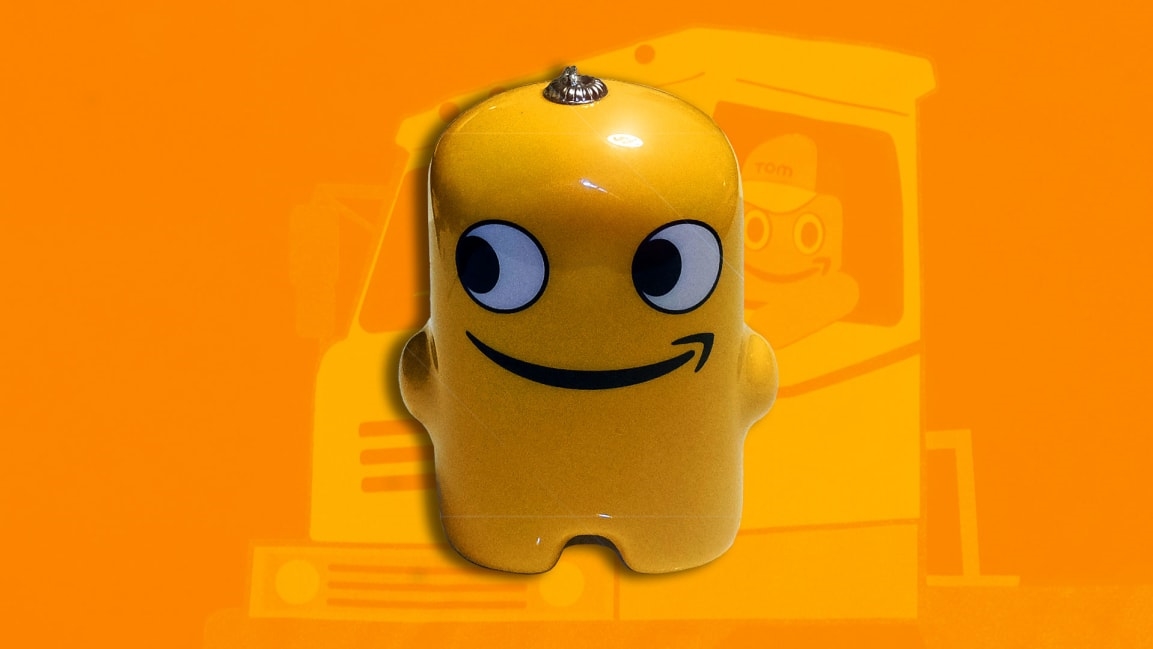Here’s Peccy, the bizarre, beloved mascot you didn’t know Amazon had
First of all, he is—I mean this as a statement of fact, not a criticism—a dumpy little blob. His arms are jointless, fingerless nubs. His legs are so vestigial that it’s not clear whether he’s ambulatory.
From his head to the toes he doesn’t have, he’s bright orange: Amazon Orange, or Pantone 1375C, to be exact. And he got his half-dimpled smile from the upturned arrow that has been part of the Amazon logo since 2000.
He’s Amazon’s mascot and cultural ambassador, Peccy.
Wait—Amazon has a mascot? I expect that this comes as news to you. Or at least it did to me. When I interviewed Amazon HR chief Beth Galetti for a profile in our new issue, we mostly talked about topics such as her unlikely career path from electrical engineer to HR pro, the challenges of hiring thousands of people a week, and her quest to use technology to better the Amazon employee experience. But as we wound up our chat, she gave me a laminated copy of the company’s leadership principles. Our conversation ended thusly, as I pointed at the character grinning from the document’s upper left-hand corner:
Me: Does this critter have a name, by the way?
Galetti: Peccy! Oh, I love Peccy. He’s called Peccy because he represents our peculiar ways. We call ourselves at Amazon very peculiar.
Me: How’s that spelled?
Galetti: P-E-C-C-Y.
Amazon PR representative: You’ll see him with a variety of different accessories, depending on what country you’re in, depending on what workplace you’re in. Sometimes he’ll have glasses, a keyboard, a hat. He’s really a master of disguise.
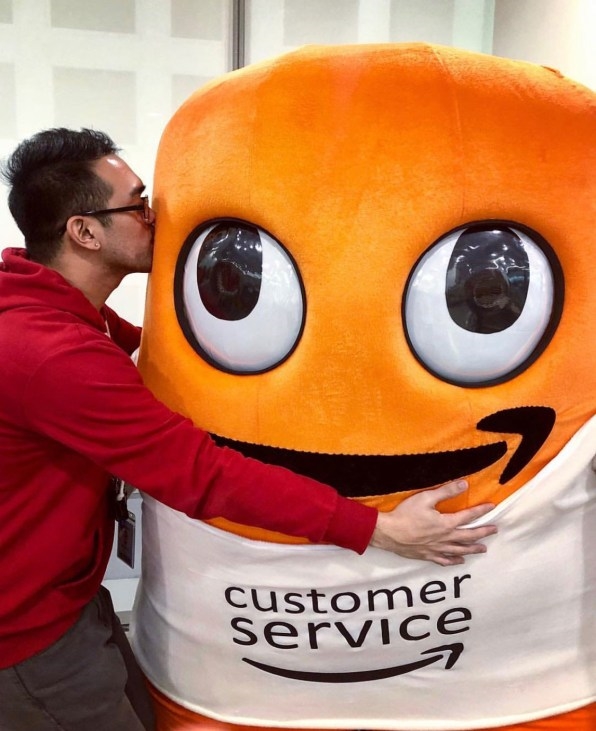
[Photo: @callmejune]
Galetti: In China, they make tiny little Peccy figurines. Everybody loves Peccy.
“Love” is a subjective term, but an awful lot of people at Amazon unquestionably find Peccy to be an affable, even inspiring symbol of the company where they work. Poke around Twitter, Facebook, and Instagram, and you will find such staffers hobnobbing with walk-around Peccys at all-hands meetings, showing off Peccy swag, and sharing Peccy-themed memes. He also gets name-checked on LinkedIn, where current and former Amazon employees list the Peccy awards they’ve won alongside other career highlights.
Peccy “stands for all strong, motivated, hardworking Amazonians,” says one Amazon fulfillment-center employee whom I contacted after noticing Peccy popping up in her social media feeds. “I happen to be one of them.”
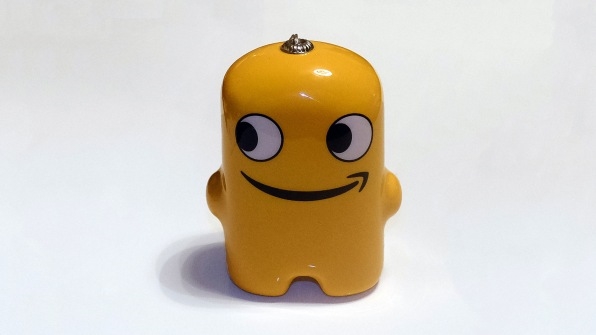
[Photo: Harry McCracken]
Asked for details about the character, Amazon says that there’s no particular story behind him. He’s just a mascot, a symbol, as Galetti told me, of the company’s belief in the power of being peculiar. Though there’s obviously more to Peccy’s history than that—somebody created him, at a specific point in time—I choose to embrace his mystique even as I attempt to understand what he means to Amazon. Discovering that he exists at all feels like being let in on a secret.
Amazon, incidentally, is a big enough outfit to have more than one popular internal mascot. Danbo—a robot made of Amazon boxes—originated in Japanese manga, was adopted by Amazon Japan, and is now a familiar totem throughout the company. Giant versions of him stood, sentry-like, right past the security turnstiles at both of Amazon fulfillment centers I have visited. But Danbo, unlike Peccy, already has achieved a measure of fame outside of Amazon—so that is all you will read about him here.
Our @WFSRuralCapJobs team met Danbo the Box Robot today, while touring @amazon‘s massive Fulfillment Center in San Marcos, with the Greater San Marcos Partnership. Amazon is hiring! Visit our offices to prep your resume & application: https://t.co/smo7k7VFPk #RuralCapJobs pic.twitter.com/ZH7ymdX8J9
— Workforce Solutions Rural Capital (@WFSRuralCapJobs) January 18, 2019
What a character
For those of us not steeped in Amazon culture, Peccy is a bit of a Rorschach test. To me, he brings to mind Bugs Bunny’s besneakered monster nemesis Gossamer as well as Horatio, a genial li’l fella, voiced by Owen Wilson, whom Hertz briefly tried to convince us to love. I must confess that I also find him oddly reminiscent of Jeff Bezos, who is noted for always seeming to be in a good mood, though I imagine any similarity is purely coincidental. My wife compared him to venerable Hostess spokespastry Twinkie the Kid. Two of my colleagues, upon seeing him for the first time, independently brought up Philadelphia Flyers mascot Gritty—who might well be Peccy’s unshorn free-spirited brother.
Unlike garden-variety corporate mascots—from Elsie the Cow to the Geico Gecko—Peccy was never meant for public consumption. The closest thing I can find to an acknowledgment of his existence on Amazon’s site about itself is an uncaptioned photo of him beaming inside a fulfillment center in Dresden. HelpPeccy, a hackathon-project game written by a former Amazon intern, is available on the company’s app store but does not look overly official. And aside from a few (unsanctioned?) items of apparel offered by third-party sellers, there is no Peccy merch for sale on Amazon.com. The place to go for that is eBay, where there’s a fair amount of it, presumably being offloaded by Amazon employees.
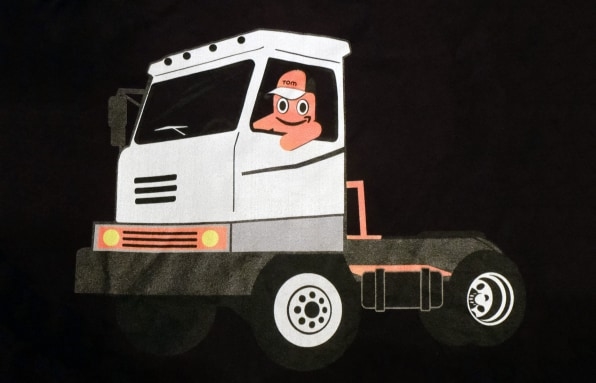
[Photo: Harry McCracken]
If you work at the Kent, Washington, Amazon fulfillment center I toured, however, Peccy graces your presence the moment you enter the facility. He’s peering down from a sign listing the “Peculiar Ways” that gave him his name:
Several of these credos—such as the first three—describe qualities that are recognizably Amazonian even to us outsiders. Others, like the last one, are more cryptic. And I’m still trying to figure out why one Peculiar Way is unabashedly pro-bragging while the next maintains that the company tries to avoid a boastful tone. In any event, Amazon doesn’t have a problem with people finding its culture—which is simultaneously envied, imitated, and questioned—to be a tad peculiar. Indeed, it’s a point of pride, and Peccy, though he doesn’t generally speak, is its advocate.
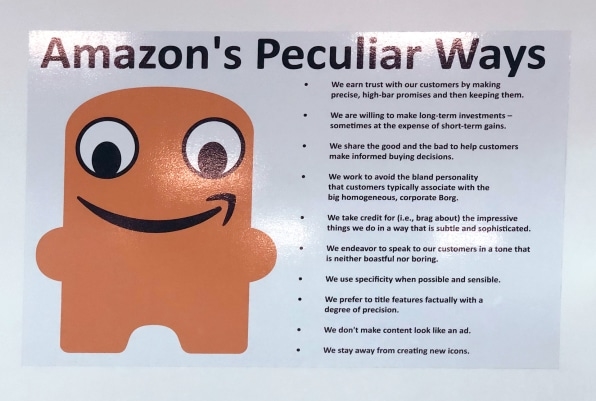
[Photo: Harry McCracken]
But if Peccy ever devoted himself exclusively to promoting the Peculiar Ways, those days are long over: “He was everywhere,” says one ex-Amazonian, who found Peccy’s use in corporate communiqués a touch patronizing. A flyer distributed to prospective employees for a facility in Kenosha, Wisconsin, featured Peccy in a doctor’s coat (in a section about medical benefits) and fantasizing about money (in one about bonuses and Amazon’s Career Choice program, which covers training costs for high-demand occupations). Once hired, those recruits might have found him in their onboarding materials. From there, they could have acquired Peccy gear such as hats, T-shirts, socks, and water bottles.
I got these two Peccy pins from my Ambassador swag bag. They’re so cute! #amazon #behindthesmile pic.twitter.com/V1gKDvfguT
— Nere (@Morb2) January 24, 2018
And oh, the pins. There are ones depicting Peccy as Superman, Wonder Woman, Harry Potter, Chewbacca, Sherlock Holmes, a ninja, both Mickey and Minnie Mouse, Mr. T, Richard Simmons, and multiple Game of Thrones characters, just to share a few examples that recipients have posted to the web. Some of these pins are given to employees for achievements such as perfect attendance—a feat more conscientious than peculiar, and evidence that Peccy is, as much as anything, an adorable manifestation of warm, fuzzy feelings about Amazon.
As far as I can tell, no central Amazon organization maintains tight control over Peccy and his image. Various arms of the company have commissioned multiple instances of Peccy baked goods, sculpture, and costumery, none of which are precisely alike and some of which prove that his deceptively simple form isn’t so easy to translate into other media. Still, he remains Peccy, even if he’s eight feet tall and made of balloons.
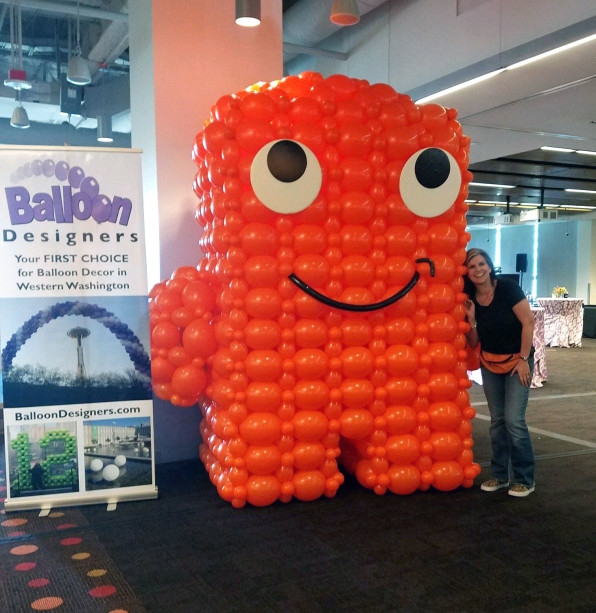
[Photo: courtesy of Balloon Designers]
He also seems to transcend cultural boundaries with ease. As I pinged people who had posted Peccy imagery, I found myself talking to folks such as a woman in the Philippines who had helped her sister create Peccys wearing local outfits such as a Maria Clara gown for an Amazon employee contest. In Mexico City, artist Miguel Ángel Castillo Martínez has created ornate Huichol figures of Peccy, a process requiring a profusion of colorful beads, some epoxy, and about a month of labor. He says that the project began with a request from Amazon to “make something cool” and has one of the resulting Peccys up for sale with a price of $10,400.
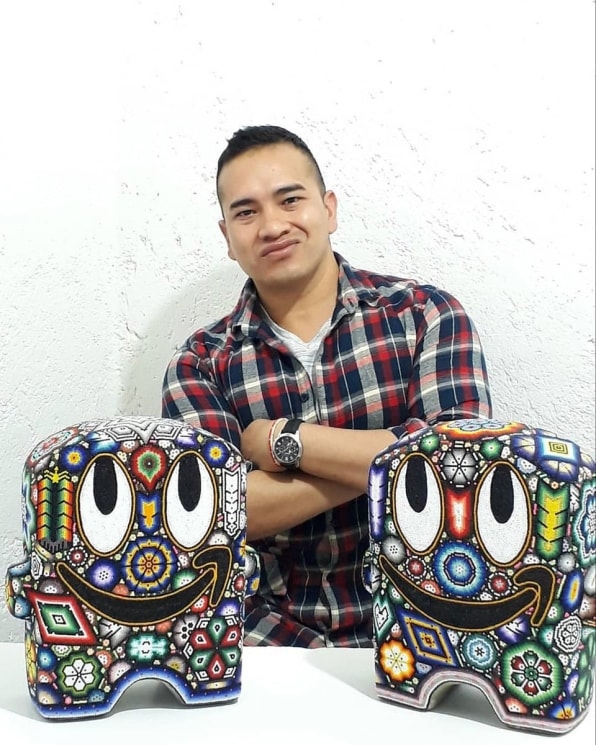
[Photo: courtesy of Miguel Ángel Castillo Martínez]
If Peccy had a more clearly defined personality—avuncular like Rich Uncle Pennybags, say, or boisterous like Kool-Aid Man—he might not appeal to so many Amazon staffers in so many places. Which, after all, is his whole reason for being.
Peccy and his critics
Inside Amazon, Peccy is such a pervasive representation of the company that it’s no shocker he’s been adopted by detractors as well as boosters. For instance, The FACE of Amazon, a group of former and current Amazon employees, retweets negative items concerning working conditions at the company from a Twitter account whose avatar is a Peccy with a frown—the Amazon arrow turned upside-down, naturally—and a black eye.
Then there’s artist Hiba Ali. Her interest in the history of shipping led to an interest in Amazon, which turned into a video performance called To Be a Box, in which she critiqued the company’s employment practices by taking on the guise of an Amazon box. Last year, after creating that piece, she spent a month working at an Amazon fulfillment center in Austin—in part as a research exercise, but also to make money. That’s where she encountered Peccy on signage. “I would see this smiling cartoon and I would wonder where the mascot was from and why he was encouraging us to work and smile and be happy,” she says.
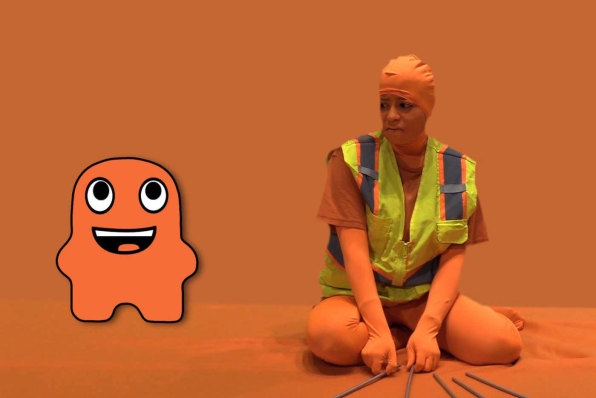
[Photo: courtesy of Hiba Ali]
Ali was also intrigued by Peccy’s orange hue, which reminded her of the trim used on the vests Amazon employees wear to make themselves highly visible to the drivers of shipping vans at the company’s facilities. “Orange is the color of precarious labor,” she explains. “It’s both the color of danger and safety.” She channeled this observation into Abra, another video performance in which she—in orange skullcap, makeup, and garb, along with a safety vest, against an orange backdrop—converses with a “sarcastic and friendly” Peccy about “labor conditions and financial conditions and what the future of work looks like.”
“Peccy serves as this perfect example of what Amazon represents on a societal level,” says Ali. “It makes this big company intelligible to us through marketing.” So far, that marketing has been conducted entirely to Amazon employees. Will the company ever introduce him to Amazon customers? Probably not; modern tech companies do not generally feel the need to have mascots. (Happy exception: PagerDuty’s internal character Pagey, a footloose anthropomorphic pager, helped that company celebrate its IPO this week.)
Still, now that I know Peccy exists, I’m glad he does. He’s been hiding in plain sight all along, ready to be the vessel for our feelings about Amazon, no matter how positive, negative, or conflicted.
“Peccy is everywhere,” says Ali, expressing a sentiment that would be equally logical coming as praise from an Amazon admirer. “Because his smile is on every box.”
(405)


